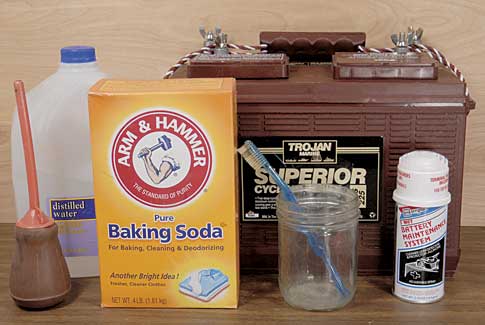
Head out after sunset, and put your skills as a marksman to the test while you fill a cooler with redfish and sheepshead.
Full-maintenance marine batteries are usually less expensive and lighter than maintenance-free models with the same amount of cranking power and reserve capacity. If you are a serious fisherman and need maximum storage capacity so you can run your trolling motor after other anglers run out of juice, you will find that the batteries with the highest reserve capacity ratings are full-maintenance models.
Unfortunately, full-maintenance means exactly that: regular cleaning and servicing that can put acid holes in your clothes. These batteries use water that must be replenished through removable, vented cell caps.
A charger must take them to the point of gassing in order to deliver a full charge. Water is vaporized during this process and pushed out through the vents along with tiny droplets of acid. The resulting mess on the battery top must be removed before it builds up enough to cause a low-grade short between the battery terminals. A battery’s terminal connections also collect this crud. The battery posts and ring terminals connected to them need the same kind of cleaning to prevent corrosion and bad connections.
Flooded-cell batteries like these must be recharged as soon as possible after each discharge to prevent sulfation. A battery produces power as acid leaves its liquid electrolyte and combines with the lead in its plates.
Recharging the battery returns the acid to the electrolyte. The longer you leave the acid combined with the plates, the more difficult it is for the recharging process to drive it back into the electrolyte. It can form a sort of crust on the plates (sulfation) over time, and as the crust grows, it reduces the amount of the plate’s surface area available to the acid, reducing the battery’s available power.
Some boaters buy full-maintenance batteries to save money and get more power, then don’t maintain them properly and fail on both counts. Let the cell water levels drop far enough to expose the plates, and the plates can get hot enough to warp and touch each other, effectively killing the battery.
Regularly let discharged batteries sit for a week or two before charging them, and sulfation will kill them in one season.
The least-expensive type of maintenance-free battery is a flooded-cell model with caps that are not removable. These batteries use special plate alloys that limit gassing and have cell reservoirs large enough to keep the electrolyte above the plates throughout the battery’s expected lifetime. They are still vented, and while they don’t gas like full-maintenance models during charging (unless you overcharge them), they still need an occasional top and post cleaning.
Absorbed glass mat (AGM) batteries are sealed and rarely need more than a seasonal cleaning. They have a type of matting compressed between their plates that absorbs all the liquid electrolyte. There is no free liquid in their cells, and they won’t leak even if their case is punctured.
Since the cell plates are partially supported by the tightly packed matting, they don’t need any alloys added for strength and can be pure lead. AGM models also have very low internal resistance, so they charge fast and give up current freely during use.
Gel-cell batteries differ from AGMs. They start out filled with liquid electrolyte that is then gelled with the addition of silicates. These batteries act much like AGMs, but they have a longer storage life, are not much bothered by sulfation and must be charged with less gusto than AGMs or flooded-cell models. A charger built to fully charge a flooded-cell battery can cook a gel battery in short order.
On the down side, sealed, maintenance-free AGM and gel batteries are usually heavier and considerably more expensive than full-maintenance models. Which is best for you? It all depends on your budget and how much maintenance you are willing to do.


